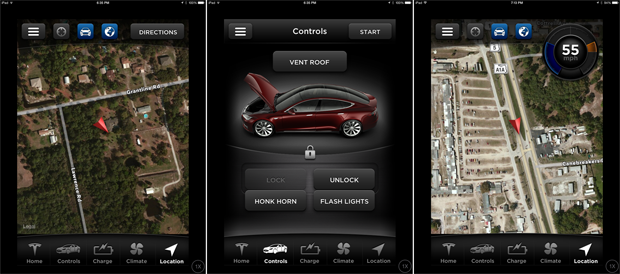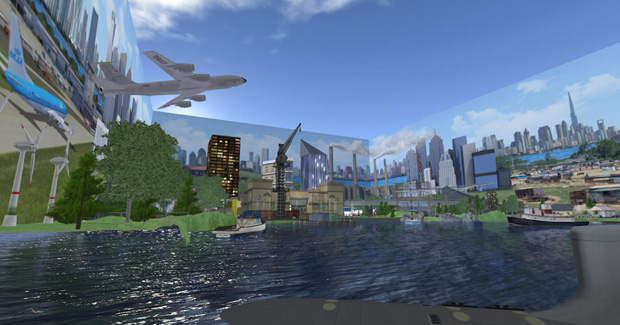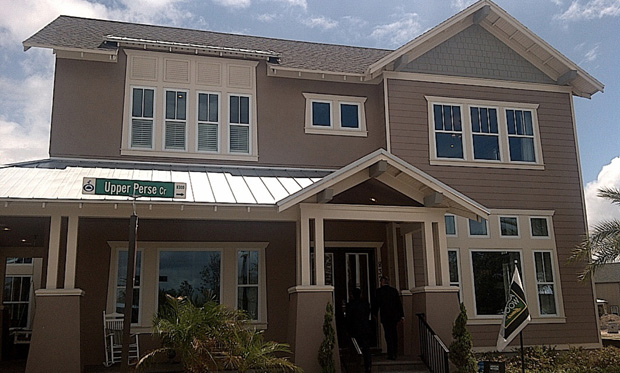Above: The Lake Nona Intelligent Home Living Laboratory.
Orlando, Florida, has always been known as the epicenter for simulation, with a robust ecosystem of supporting engineering and communication technology. Recently, a new model for robust simulation and testing of new technologies and innovative processes has been put in place that offers a living laboratory to examine advanced use cases and technology interoperability in a unique, realistic series of testbeds.
In a rare partnership, several organizations (i.e., the University of Central Florida-Institute for Simulation and Training, College of Medicine, College of Engineering and Computer Science along with community partners, such as Lockheed Martin, NASA Kennedy Space Center, Lake Nona Institute, Guidewell Innovation, Johnson & Johnson, Cicso, and the Department of Defense) are creating simulated testing environments to examine new technologies in the home, at work, in the city/community, in vehicles, and also in industrial/government environments. The sites are a mix of live, virtual, and constructive environments. Ultimately, these simulated environments provide a living laboratory for exploring and testing the application, impact, and security of the Internet of Things (IoT), (e.g., interconnected computer and wearable devices, machines, and appliances). Following, we present the elements of Central Florida’s IoT Living Laboratory and related benefits.
What is The Central Florida IOT Living Laboratory?
The University of Central Florida, as America’s Leading Partnership University™, is developing five test ranges to serve the needs of robust IoT and cybersecurity testing that are required to promote the health, security, and wellbeing of every member of the community. These test ranges make up the Central Florida Living Laboratory and include the (1) National Cyber Range, (2) Global Institute for Cybersecurity + Research, (3) Intelligent Home Living Laboratory, (4) Virtual IoT Emporium, and (5) Connected Vehicle.
The primary benefit of these ranges is the capability they provide to rapidly test live, virtual, and constructive scenarios towards signal integration and applied use case activities across an array of interconnected systems and components (i.e., IoT). Example projects that may benefit from the use of these ranges include: advanced cyber visualization methods, secure distributed computing across multiple mobile devices, scenario planning across multiple domains of use, coordination of standards and policies, cyber maneuver, securing supply chains, and technical and trade studies on interoperability between ever-growing numbers of interconnected devices across the IPv6 spectrum.
Let’s take a closer look at each of the five main test ranges and how, together, they form the Central Florida Living Laboratory.
National Cyber Range
The National Cyber Range is a model of the Internet that was built to simulate and test the effectiveness of cyber defenses. The range supports a diverse user base by accommodating a wide variety of event types for Research & Development (R&D), Operational Test and Evaluation (OT&E), and information assurance, compliance, malware analysis, and user communities. Up to four concurrent tests of complex, operationally representative network environments are supported at varying classification levels. The range provides rapid emulation and automation to scale up high-fidelity virtual nodes, including specialized systems such as weapon systems.
Benefits of the National Cyber Range include efficiencies that enable more frequent and more accurate events to reduce timelines and support agility. Additionally, human error is minimized allowing for greater repeatability. Furthermore, sanitization is provided to restore exposed systems to a known, clean state. Assets can therefore be reused even when they are exposed to the most malicious and sophisticated uncharacterized code [1].
Global Institute for Cybersecurity + Research (GICSR)
The Global Institute for Cybersecurity + Research (GICSR) has been established at NASA/Kennedy Space Center. GICSR represents a strategic, international, collaborative partnership to advance critical infrastructure resilience. Activities include cybersecurity research using emerging technologies to promote the development of intelligence, information sharing, response capabilities, and role/performance-based awareness and workforce education. Sector services, assets, and requirements are defined to map assets to contributions and support resiliency. Risk assessment ensures reliable services delivery. Physical and cyber response protocols are aligned providing security.
Intelligent Home Living Laboratory
The Lake Nona Institute provides a range simulator as an intelligent home co-sponsored by Johnson & Johnson, Cisco, General Electric, Healthcare Information and Management Systems (HIMSS), and Florida Blue.
The intelligent home is designed with multiple connected interfaces, devices, and appliances. It provides an environment that models how individuals and healthcare providers can work together to fashion a home that will improve and maintain the overall health and well-being of its dwellers [2]. In addition, the home features advanced air and water purification systems and circadian lighting strategies.
In 2012, Cisco named Lake Nona one of nine “smart + connected” cities. Lake Nona represents the only smart city in the United States. The home has lighting, temperature, window shades, energy, utility, and media management that can be controlled through a smart, mobile device from anywhere using as much as 200 times faster Internet than commonly found in average homes.
Connected Vehicle
Increased vehicle safety is a driving force in the development of Connected Vehicles (CV) technologies (see figure below). As U.S. Transportation Secretary Anthony Fox stated in a public address at the beginning of 2014, “vehicle‐to‐vehicle technology represents the next generation of auto safety improvements, building on the life‐saving achievements we’ve already seen with safety belts and air bags.” Rather than reducing the impact of accidents after they have occurred, a CV will avoid the catastrophe altogether through advanced warnings and alerts.

These systems will improve driver situation awareness to prevent many common accidents from ranging or passing cars to running of red lights. The National Highway Traffic Safety Administration released a report in 2014 on the readiness for vehicle-to-vehicle communication that makes a strong case for the economic impact, and more importantly, lives saved with CV technologies.
With a clear need for CV’s to facilitate new safety applications, there is also a strong need to identify the best methods for alerting drivers to this critical information. Specifically, designers of CV warning systems must ensure that auditory, visual, and tactile displays alerting drivers are implemented such that they improve situation awareness without causing unsafe distractions which may increase the likelihood of accidents. The objective of this task is to empirically evaluate multimodal displays to identify best practices in the design of CV warning and alert technologies.
Virtual IoT Emporium

The IoT Emporium (see above), sponsored by the Army Research Lab and the University of Central Florida (UCF), is a virtual cityscape comprised of homes, offices, roadways, docks, airports, communication centers, warehouses, and other virtual spaces for avatars to explore complex use cases.
Constructive simulation is becoming more practical to use for collaborative, rapid prototyping to model and integrate physical environments. In 2015, the Army Research Lab supported an online workshop using OpenSimulator that resulted in the 3D virtual world. This effort brought military, government, industry, and educational sectors together to share research and development around the platform. The experimental event, called the Federal Consortium of Virtual Worlds (FCVW) Workshop, provided regions for avatars to explore and experience fully online at a distance. A prototypical megacity was made to illustrate the impact of IoT on multiple industries such as shipping, transportation, military communications, manufacturing, emergency management, medical simulation, and housing [3]. Simulating human in the loop behaviors is cost-effective and adaptable where participants constructively engage in the virtual IoT Emporium from anywhere and, in some cases, s anytime. The low cost, collaborative potential of the MOSES platform make the IoT Emporium a virtual range for promoting cultural change.
Conclusion
The Central Florida IoT Living Laboratory promotes a user-centered process, experimentation in real-life environments, and provides an innovative way for simulating and testing through interconnected test ranges. Findings will be shared with community collaborators including the general public, private companies, and organizations involved in research and development.
This article presented the physical and virtual test ranges that make up a living laboratory for testing real world applications of the Internet of Things, wearables, and unique integrations and interoperability. The IoT Living laboratory is comprised of National Cyber Range, Global Institute for Cybersecurity + Research, Intelligent Home Living Laboratory, Virtual IoT Emporium, along with the Florida Department of Transportation’s self-driving car simulator. Future R&D applications will involve the interplay of the ranges to enrich scenario-based use cases involving diverse stakeholders across the region.
The University of Central Florida’s interdisciplinary partnership strengths are primed for researching the ongoing security, privacy, and benefits for the IoT. The METIL Lab at UCF has developed The Internet of Things (IoT) Wiki as a resource for industry, academia, and the general public to use when researching, developing for, and living within the Internet of Things. The Wiki includes a glossary of terms and information about applications, services, and interoperability in the field of IoT.
The next time you’re in Orlando for a conference or a visit, contact us for a review and tour. UCF strives to be the partnership university and, in that spirit, we welcome opportunities to extend this world-class capability to applied testing and clinical trials, research and development activities from industry, academia, health and government/military. For more information, please contact info@metil.org or dmetcalf@ist.ucf.edu.
Please note that EMBC’16 will be held in Orlando, Florida, August 16-20 at Disney’s Contemporary Resort.
References
- OSD-Office of the Undersecretary of Defense, “National Cyber Range Overview,” 2015. [Online].
- Cisco, Dais Technologies, Florida Blue, Lake Nona Institute, United States Department of Veteran Affairs, University of Central Florida, and Johnson & Johnson, The Health Impact of the Intelligent Home [Whitepaper], 2013.
- B. Truman and D. Metcalf, “Advancing Interagency Collaboration through Constructive Simulation: Results from the 2015 Federal Consortium of Virtual Worlds Workshop,” in Proc. of the HCI International 2015 Conference, Springer, 2015.



